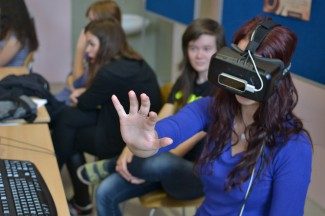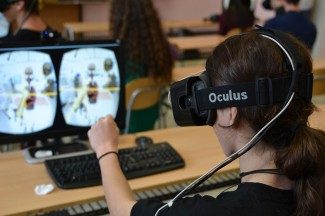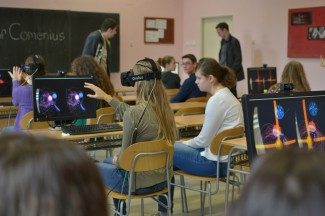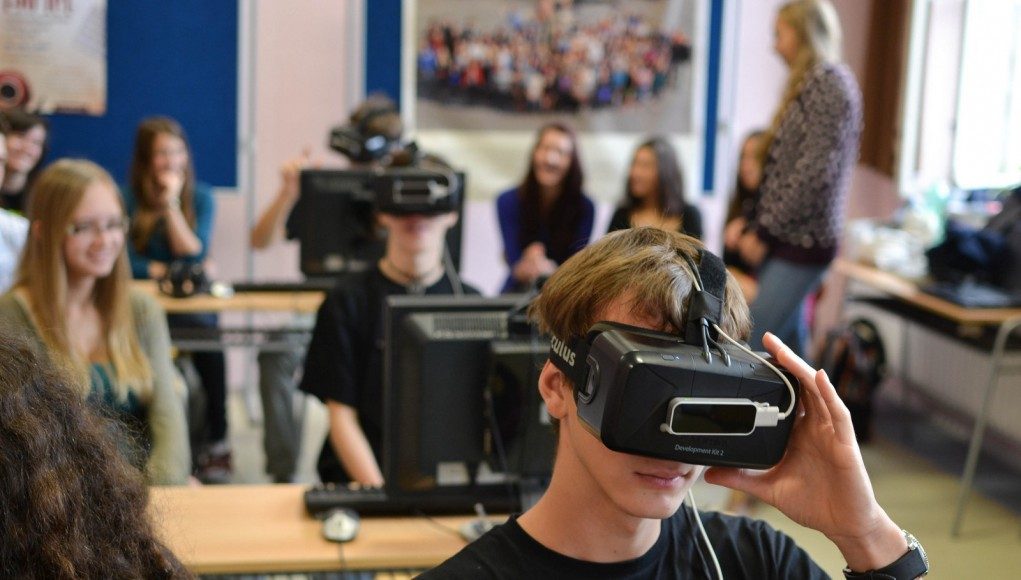At a school in the Czech Republic on October 20th, a groundbreaking experiment took place. Instead of pens and paper, students sat down with specially adapted VR headsets (Oculus Rift DK2s) that dropped them into a fascinating, immersive, educational experience that allowed them to interact naturally using natural hand gestures. This is the World of Comenius.
World of Comenius Goes to School
 As a kid, I didn’t much care for school. I loved to learn things, but as a shy child I never liked to ask for help from the teacher which meant that if the single textbook I had to learn from didn’t make sense to me, my options for grasping the subject at hand was limited. I also found the way in which information was presented in the classroom generally pretty dull and difficult to engage with. This was well before the widespread adoption of the internet too (yes I’m that old). This is why I think a new project from the team behind Sightline demonstrates the potential for VR to change-up the way we’re taught.
As a kid, I didn’t much care for school. I loved to learn things, but as a shy child I never liked to ask for help from the teacher which meant that if the single textbook I had to learn from didn’t make sense to me, my options for grasping the subject at hand was limited. I also found the way in which information was presented in the classroom generally pretty dull and difficult to engage with. This was well before the widespread adoption of the internet too (yes I’m that old). This is why I think a new project from the team behind Sightline demonstrates the potential for VR to change-up the way we’re taught.
World of Comenius, a project which started life with that goal (to enrich the learning experience) in mind, recently installed seven PCs each with the Oculus Rift DK2 VR headset, with mounted Leap Motion sensors, into a classroom at Mendel Grammar School in Opava City, Czech Republic. The school has a history of adopting progressive technologies that allow them to focus on the needs of their students and explore new and interesting ways to teach.
 For this event, pupils were treated to a virtual biology and anatomy lesson. Donning the Oculus Rift, they’re transported to a virtual classroom with a skeletal model complete with interactive components, like bones and organs. The students reach into this world and can manipulate parts of the model at will, using just their hands.
For this event, pupils were treated to a virtual biology and anatomy lesson. Donning the Oculus Rift, they’re transported to a virtual classroom with a skeletal model complete with interactive components, like bones and organs. The students reach into this world and can manipulate parts of the model at will, using just their hands.
The Leap Motion controller, a device which captures infrared light, picks up the movement of your hand and interprets gestures as commands within the application. For example, clenching your fist allows you to ‘pull’ the world around you (or perhaps your position in the virtual world). Pointing assertively at an object ‘selects’ it and then snaps it to your virtual hand’s orientation, allowing you to manipulate it in virtual space. Using the Oculus Rift’s positional tracking, users can glance around objects while rotating them to get a better look.
All of this means that World of Comenius is incredibly intuitive. With no mouse, keyboards or complicated joypads to familiarise themselves with, students are free to interact with the virtual world as they might the real world, using their hands to pick up, examine, and discard different organs from the dummy.
 For many students, it was their first experience with the Oculus Rift and virtual reality and reactions were positive both to VR and the project itself. The Leap Motion’s tracking glitched on occasion, but it enabled a level of intuition such that students were able to largely teach themselves how to use the application and then go on to teach others, all in a matter of minutes. What’s more, the air of collaboration and excitement the technology generated as pupils share what they’d learned and passed on tips to those who followed them, proves how an engaging educational experience can enliven a classroom.
For many students, it was their first experience with the Oculus Rift and virtual reality and reactions were positive both to VR and the project itself. The Leap Motion’s tracking glitched on occasion, but it enabled a level of intuition such that students were able to largely teach themselves how to use the application and then go on to teach others, all in a matter of minutes. What’s more, the air of collaboration and excitement the technology generated as pupils share what they’d learned and passed on tips to those who followed them, proves how an engaging educational experience can enliven a classroom.
After the lesson was done, the World of Comenius team took the opportunity to help evangelise virtual reality further by showing pupils other VR demos, such as Sightline: The Chair. This being school, those who’d already experienced the demo took great delight in shaking the current player’s chair as it reached the final scene, a hair raising moment where the player balances atop a collapsing building.
See Also: Why ‘Sightline: The Chair’ on the DK2 is My New VR Reference Demo







